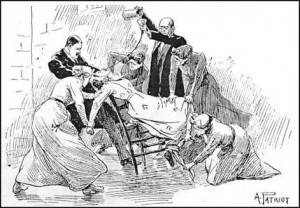Very quickly because I’m in the middle of bashing at this chapter, but saw this today and thought it was interesting (I am nothing if not predictable): In pictures: Suffragettes storm the Houses of Parliament for feminist lobby, with more background on it from the Olympics Opening Ceremony.
From the article:
When Gail Collins stepped out in front of the deafening 80,000-strong crowd watching the Olympics opening ceremony, wearing a high-neck Edwardian blouse and the purple, white and green sash that marked her out as one of Danny Boyle’s 50 suffragettes, she couldn’t hear the noise, just the beating of her heart. “It was one of the biggest days of my life,” she said. “Getting married, having my children and being in the opening ceremony. I felt proud, really proud that we had got there.”
In the months before the ceremony, the women forged a particular bond – with each other and the women they were representing. So when the experience ended, what did the Olympic suffragettes do? They kept marching.
Dozens of suffragette performers, led by Helen Pankhurst, great-granddaughter of Emmeline Pankhurst, plan to march on parliament, at the vanguard of a major feminist rally organised to urge MPs to stop “eroding erosion of women’s rights” and make more progress on women’s equality.
[…]
No longer under the guidance of Boyle – who included the suffragette section in the ceremony after becoming enthralled by the memorial plaque to Emily Davison, found on the back of the broom cupboard door where she once hid in the House of Commons – the group may treat observers to a scaled-down version of their performance. It may even include the critical moment, which to the annoyance of many wasn’t featured in the TV coverage, when the women formed a human scaffolding to carry a Christ-like Davison above their heads.
I find it fascinating because it demonstrates present day understandings of suffragettes very clearly. One of my chapters has the working title “Public figure and private nuisance: the problem of Emily Wilding Davison” and focuses on discourses of Davison and the WSPU in the days and weeks after her actions at the 1913 Derby. Davison, the WSPU’s wild child, often acted unpredictably and in ways that challenged the autocracy of the WSPU leadership. However, her actions were often innovative and headline grabbing – none more so than when she was struck by a horse at the 1913 Derby. I argue that the newspaper representation of this shows the WSPU bringing her under their aegis so they could make her their martyr. Davison occupied an interesting and complicated place within the WSPU and the wider suffrage movement, so I find the image of a “Christ-like Davison” intriguing.
I also want to find out more about remembering and history and what it means to summon these ghosts and remake them for present day issues, but that will have to wait until after I submit.
References:
Rosen, A. (1974). Rise Up, Women! The Militant Campaign of the Women’s Social and Political Union 1903-1914. London: Routledge
Stanley, L. and Morley, A. (1988) The Life and Death of Emily Wilding Davison. London: Women’s Press

